EXERCISES TO STIMULATE BOWEL MOVEMENT - 7 TYPES FOR EVERYONE
- Medically reviewed by: Horia Marculescu, MD
- Photo credits: Licenses / Author
- Last updated: 27.03.2024
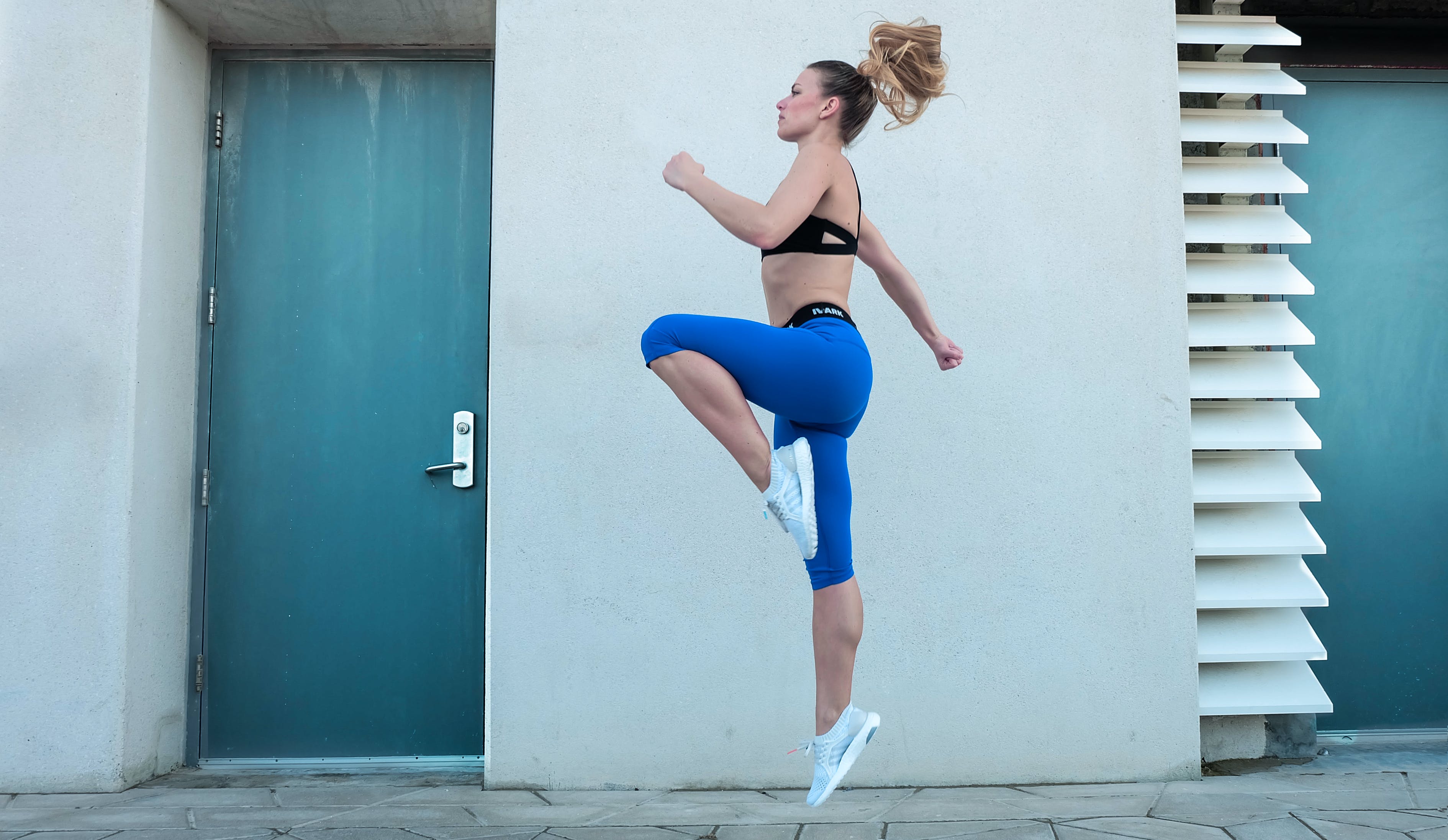
Improve your digestive health with a series of exercises to stimulate bowel movement. Explore the following exercises:
- Walking;
- Jogging;
- Jump Rope;
- Deep Breathing;
- Deep Squatting;
- Wind-Relieving Pose;
These exercises stimulate intestinal motility by contracting the muscles and expanding the lungs.
They maintain the health of the gastrointestinal tract and shorten the time the stool passes through the intestines.
Also, they are excellent for working out and relieving stress by creating adrenaline. Follow the guide and get the most out of the benefits in the long term.
1. WALKING
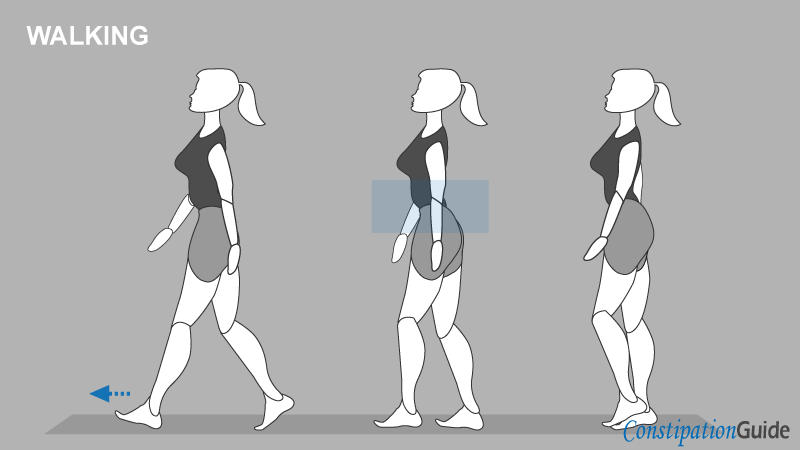
Walking is one of the most effective exercises to stimulate bowel movement because it makes the entire body move and the abdomen contract and expand.
Abdominal muscle contraction will improve motility by stimulating and creating more intestinal waves so the stool will move toward the rectum.
Walking can unglue portions of the stool inside the large intestine that act as a sticky glue if you suffer from dehydration.
It is beneficial for individuals recovering from surgery or trauma. It is an excellent option for those who may not be at their peak physical fitness level.
How to Walk to Stimulate Bowel Movement:
- Put on a pair of elastic pants.
- Wear comfortable shoes.
- Opt for a clean cotton shirt to manage sweat.
- Tie your shoelaces securely and ensure a snug fit.
- Step outside and commence walking.
Begin with a warm-up consisting of stretches aimed at relieving constipation. Prepare your body and muscles for physical exertion. During the initial ten minutes, maintain a slow pace with deliberate steps.
Increase the speed gradually after ten minutes of walking at a slow pace. Maintain this brisk pace for 30 minutes without taking any breaks.
After 30 minutes of walking, take a 5-minute break and relax. Try to inhale and exhale deep and slow to get as much oxygen in your lungs.
A simple example of walking for beginners:
- Begin by walking for 15 minutes at a slow pace.
- Gradually increase your pace.
- Walk for 30 minutes in an alert mode.
- Take a 10-minute break.
- Practice deep and slow breathing during the break.
Repeat these 30-minute intervals 2-3 times with breaks (totaling 60-90 minutes of walking). If you lead a sedentary lifestyle, it's essential to start slowly. This advice also applies if you're new to physical activity aimed at stimulating bowel movement.
If you're in good physical shape, consider increasing the intervals to 40 minutes each, totaling 80-120 minutes of walking.
What Do The Health Experts Say?
A study on therapeutic yoga and walking for patients with IBS, published by The U.S. National Library, suggests that walking benefits patients with IBS. It is even more effective in the long term when utilized as a self-regulated walking program.
The Physical Activity Guidelines for Americans (2nd ed), published by The U.S. Department of Health and Human Services, recommend 150 minutes of brisk walking per week to reduce the risk of numerous chronic diseases and health issues.
According to the guide on Measuring Physical Activity Intensity, published by The U.S. Centers for Disease Control and Prevention, brisk walking should not entail race-walking but preferably maintaining a speed of at least three miles per hour or more.
2. JOGGING
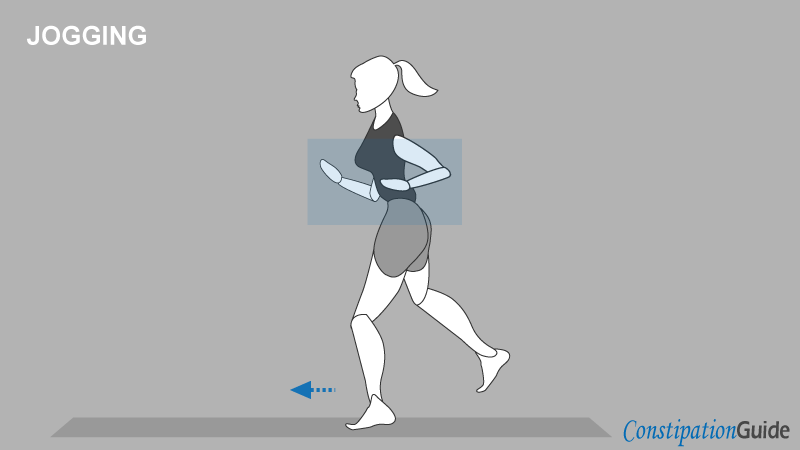
Jogging is similar to walking, and it is one of the most effective exercises to stimulate bowel movement because it puts the entire body to work.
Moving all body parts, particularly the abdomen, can enhance bowel movements through muscle contractions and increased intestinal pressure.
Also, because of the constant and intense movement of the body parts, the intestines will expand, thus creating more waves to move the stool faster for evacuation.
Jogging is the king of exercise that anyone can practice. All you need is a flat surface and some good running shoes.
How to Use Jogging to Stimulate Bowel Movement:
- Put on your running gear.
- Carefully tie your shoes.
- Head outside to a park or similar area.
- Begin by walking for 10 minutes.
- Then, transition into jogging for 30 minutes.
Walk for ten minutes to prepare your body for physical activity.
After you have warmed up your body, increase the speed of walking, and make sure you are moving the body as if you were running very slowly.
After 30 minutes of jogging, take a 5-minute break and repeat this step.
Breathe deeply and slowly to get oxygen inside the lungs. You will start to breathe faster as time passes, and the effort becomes more intense.
Training Examples with Jogging Intervals:
Increase the total jogging time to 90 minutes. Repeat 30-minute intervals three times, taking it very slowly.
Focus on maintaining a steady rhythm and breathing at a faster pace. If you're in good physical condition, consider extending the interval to 120 minutes for optimal results.
Hydration is crucial before and after this exercise. Muscles need water and vitamins for proper hydration, and adequate water intake is essential for the stool in both the small and large intestines.
What Do The Experts Say?
According to recommendations about physical activity in adults, published by The U.S. Centers for Disease Control and Prevention, The CDC recommends weekly vigorous-intensity aerobic exercise like jogging, running, or similar (for at least 75 minutes).
According to a guide called Physical Activity Guidelines for Americans (2nd ed), published by The U.S. Department of Health and Human Services, moderate-intensity exercise should include a warm-up to adhere to the ideal aerobic guidelines. For instance, brisk walking is an effective warm-up before transitioning into jogging.
3. JUMP ROPE
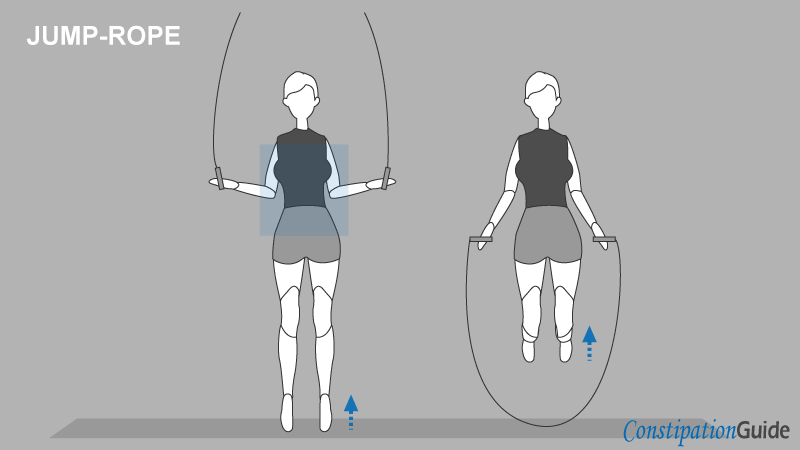
The Jump Rope exercise is one of the most fun and essential exercises to stimulate bowel movement because it puts every muscle in intense training.
Doing jump rope exercises will make the intestines move vertically up and down. In this way, vertical pressure will also push the stool towards evacuation. This thing is excellent for having fast relief in the short term.
This exercise requires effort, equipment, and a long sports rope. If you find it challenging at first, consider mastering jogging.
How to Perform Jump Rope Exercise?
- Hold the handles firmly in your palms.
- Position the rope behind your back.
- Rotate your hands from back to front to initiate the movement.
- Swing the rope from behind and propel it forward.
- Jump when the rope reaches your feet.
- Repeat the process.
Start this exercise slowly until the hands synchronize with the jump. Do not worry if you fail for the first 20-30 times. It is normal.
The purpose of this exercise is to get the internals moving and to prepare for stool evacuation.
A Basic Jump Rope Exercise Routine:
- Begin with ten slow jumps without the rope for a warm-up.
- Proceed with ten slow jumps using the rope.
- Take a brief break.
- Follow up with 15 quick jumps.
- Take another short break.
Repeat this sequence 3-4 times, focusing on jumping as vertically as possible. After completing two sets, you should start feeling your abdominal muscles engaging.
Also, you will feel the stool and the gas inside the intestine moving. The presence of gas inside is natural, but be aware of too much gas. This exercise helps you relieve gas and constipation, amongst others.
Try to keep balance as much as you can when rotating the hands. Try not to move too much in front or back, and try to stay in the same place where you started.
What Do The Experts Say:
According to a study on jump-rope-based physical activity and fitness promotion in adolescents, published by The U.S. National Library of Medicine, after a 12-week study, jump-rope exercises demonstrated significant improvements in muscular strength and flexibility. Jumping rope engages both the upper and lower body, making it a whole-body movement.
According to a guide on jump-rope activity published by the CDC Healthy Schools, jump-rope exercise is an excellent aerobic workout recommended for individuals of all ages.
4. DEEP BREATHING

Deep breathing aims at the lower part of the abdomen. It also helps pelvic floor muscles contractions.
Other exercises that help digestion and constipation are sit-ups or crunches.
Ideally, aim to inhale deeply into the pelvic area. This action expands the lungs and opens the rib cage.
Next, exhale the air out of your lungs slowly and gently. Filling the lungs with air will increase their volume, thus moving the intestines. As a result, the stool inside the intestines will move towards the rectum.
How to Perform the Breathing Exercise:
- Stand with your feet aligned.
- Inhale deeply and gently, filling the lungs.
- Focus on drawing the air into the pelvic area.
- Hold the breath for 5 seconds.
- Exhale slowly.
Repeat the exercise gradually 20-30 times, avoiding any strain on the rectum. Maintain a relaxed pace throughout.
Perform this exercise once or twice daily.
Aim the breath as low as possible. Engage the pelvic area for maximum lung expansion.
It's crucial to inhale and exhale slowly and gently. The exercise is most effective when you sense the air filling the lower abdomen near the thighs and pelvic floor.
What Do The Experts Say?
According to an article from The International Foundation for Functional Gastrointestinal Disorders on gut responses and IBS, Relaxation techniques, breathing exercises, or meditation can reduce gut responses.
According to a study titled "Irritable Bowel Syndrome: Yoga as Remedial Therapy," published by The U.S. National Center for Biotechnology Information, Breathing exercises to expand lung capacity and loosening practices are helpful techniques for managing symptoms of constipation-IBS.
5. DEEP SQUATTING
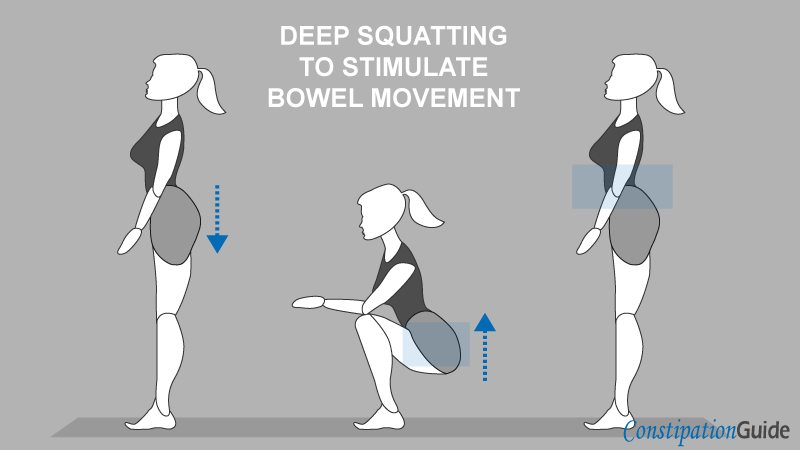
Squatting falls under the category of pelvic floor muscle exercises. It is considered one of the most effective exercises for stimulating bowel movements.
Squatting increases the anorectal angle, creating a straight pathway for stool within the large intestine and rectum.
Additionally, it applies pressure to the upper abdomen, facilitating better movement of stool. Deep squatting is a natural posture for stool evacuation and preparation.
How To Use Deep Squatting?
- Stand with your feet aligned.
- Lower your body gradually.
- Maintain a straight abdomen.
- Place your elbows on your knees.
- Keep your arms positioned between your knees.
- Hold this pose for five breaths.
- Return to the starting position.
Repeat this exercise 10-15 times slowly. Aim to maintain a foot's distance between your knees and keep your knees higher than your hips.
Always ensure your abdomen remains straight, and avoid curving your body. The goal is to engage the pelvic floor muscles and increase the anorectal angle.
If needed, you can use support to stabilize yourself during the exercise. However, concentrate on targeting the pelvic floor area, including the sphincter and rectum.
Example of Squat Training and Posture:
Hold the squat position for more than ten breaths for optimal results. You can also place your elbows on your knees and extend your arms to widen the space between your knees.
This action stretches the hips and thighs, further increasing the anorectal angle. It also prepares you for additional stretches to alleviate constipation in the future.
According to exercise guidelines for warm-up and strength training published by The American Academy of Family Physicians, exercises like squats offer numerous health benefits. You can incorporate bodyweight squats into your routine while watching TV or walking outdoors.
6. WIND-RELIEVING POSE
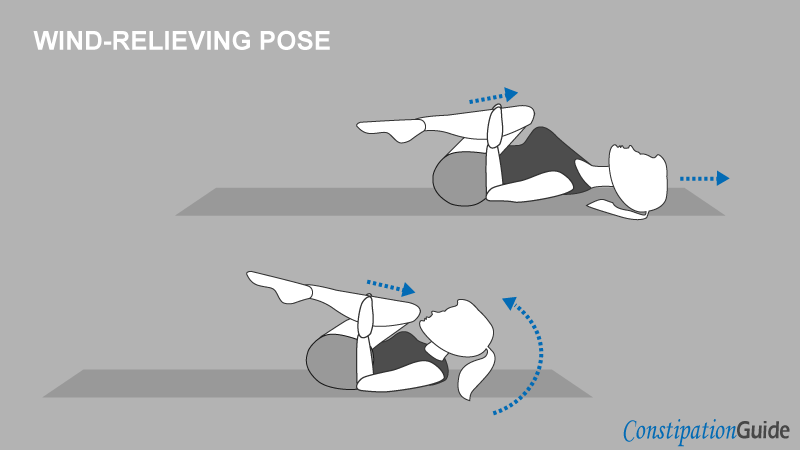
The Wind-Relieving pose is a beginner yoga pose that anyone can practice without too much effort.
This yoga pose is extremely efficient because it is similar to deep squatting and can stimulate bowel movement with slow exercises.
The movement of the knees going to the chest increases the anorectal angle and puts the pelvic floor muscles to work.
How to Perform the Wind-Relieving Pose for Abdominal Stimulation:
- Lie on your back on a mat.
- Keep your body straight.
- Bring your knees towards your chest.
- Slowly bend your back.
- Place your arms over your legs.
- Hold your knees with your arms.
- Count to ten.
- Gently release your legs and repeat.
If you're a beginner, aim to repeat this exercise slowly ten times. For those in good physical condition, aim for 15-20 repetitions.
Start slowly and gently to avoid putting excessive pressure on your abdomen and intestines.
You should feel gas and stool within your intestines moving towards the rectum for evacuation, indicating improved bowel movement.
Wind-Relieving Pose Warm-Up Example:
- Slowly bring your knees together.
- Hold the knees with your arms for five seconds.
- Gently release the legs.
- Maintain a straight body position on the mat.
- Repeat this exercise 10 times.
It is essential to start slowly and prepare your body.
A well-prepared body reacts better to pressure and tension on the intestines.
For those experiencing sluggish bowel movements, some stimulation and pelvic floor exercises may be beneficial.
According to a study on muscles and yoga postures published by The U.S. National Institutes of Health, various yoga poses activate specific muscles. These include simple movements such as sitting, forward and backward bending, twisting, inversion, and lying down in a supine posture.
7. CRUNCHES
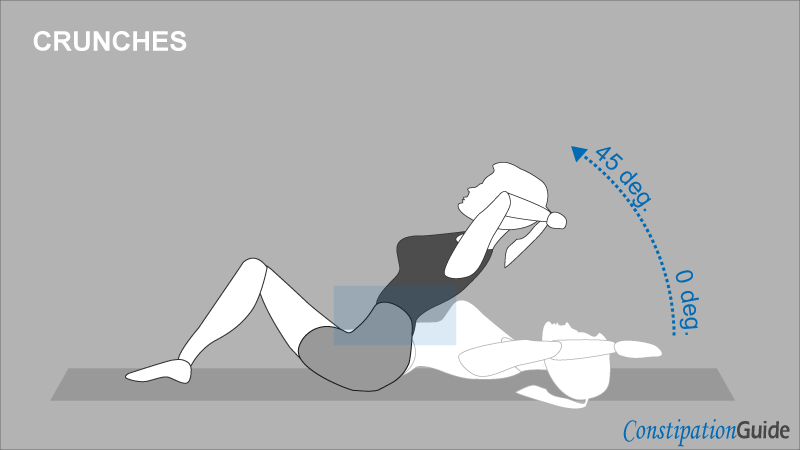
Crunches are incredible exercises for stimulating bowel movements as they target the lower abdomen and pelvic floor muscles.
With numerous variations, all crunches generate pressure within the intestines, promoting stool evacuation.
Crunches help move the stool within the intestines through body movements alone.
They contribute to increasing the anorectal angle, facilitating easier defecation post-workout.
How to Perform Crunches as a Stimulation Exercise:
- Lie on the fitness mat with your back.
- Keep your body straight.
- Lift your thighs perpendicular to the floor.
- Keep your calves parallel to the floor.
- Move your head towards your knees, simultaneously bending your back.
- Return to the initial posture.
Repeat this movement slowly ten times, starting gently. Consider doing five sets of ten repetitions. If you're accustomed to abdominal workouts, aim for 10-15 repetitions.
It's worth noting that crunches are similar to sit-ups, which can occasionally lead to constipation if performed while you are tired, dehydrated, or under stress.
According to a guideline titled "Exercising on a Budget," published by The U.S. National Library of Medicine, exercises such as lunges, squats, push-ups, crunches, jumping jacks, and leg or arm raises utilize your body weight, aiding in muscle toning.
KEEP IN MIND
All of these exercises to stimulate bowel movement are suitable for everyone.
Aerobic or cardio exercises make the heart rate increase the blood flow. Also, they will expand the lungs and open the rib cage.
If you get very dehydrated after a workout, then this thing means you have to find out what causes this symptom. If you often feel bloating, gas, and severe constipation after a meal, you should visit a doctor.
The following exercises are simple to practice and require minimal effort, including walking, jogging, deep breathing, and deep squatting.
For those seeking better results, jump rope exercises, the wind-relieving pose, and crunches are ideal.
According to an article about abdominal pain, symptoms, and causes published by The American College of Gastroenterology, both the brain and gut can transmit nerve signals or release chemicals that may lead to gut sensitivity and abdominal discomfort, similar to the sensations experienced during stretching and gas bloat.
Last medically reviewed on 27.03.2024
TRUSTED MEDICAL SOURCES
1. The ASCRS textbook of colon and rectal surgery. Szmulowicz U., Hull T.
